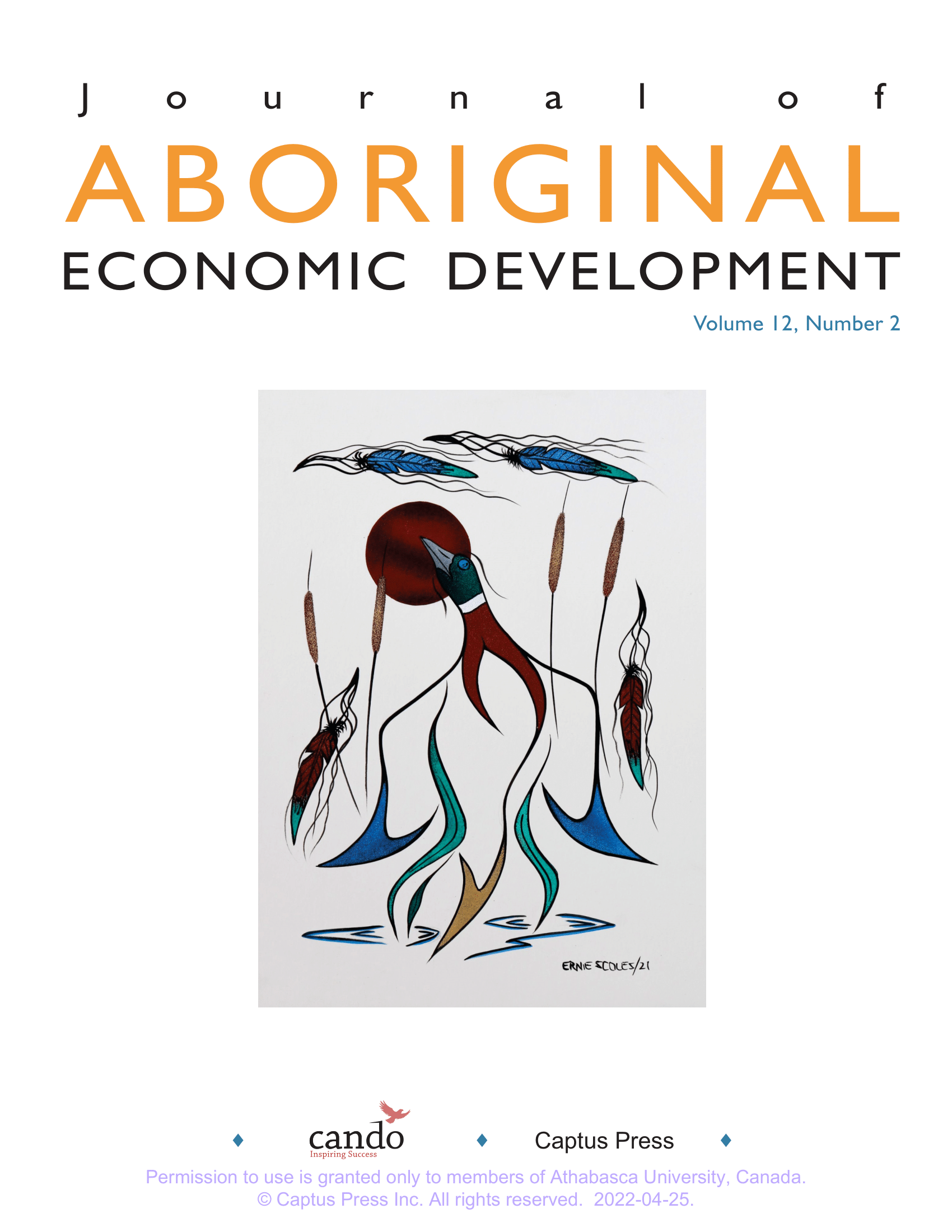Guide for First Nation–Municipal Collaboration on Economic Recovery and Resilience
DOI:
https://doi.org/10.54056/YLZR3671Keywords:
Business And Economics, Collaboration, Communication, Coronaviruses, Cost control, COVID-19, Economic development, Economic recovery, Emergency preparedness, Ethnic Interests, Evacuations & rescues, Funding, Government, Health status, Leadership, Native North Americans, Planning, Resilience, Stimulus, Indigenous , Indigenous businesses, Indigenous businesses in Canada, First Nation-owned Businesses, self-governanceAbstract
There are many reasons for First Nations and municipalities to collaborate on emergency management and economic resilience: * improved outcomes in regional recovery by having diverse and representative voices at the table * cost savings, resource sharing, and more efficient service delivery * greater health and wellness outcomes for all, including the most vulnerable * increased ability to access stimulus funding from other orders of government * increased community resilience and capacity to respond together in future emergencies This guide is a framework for collaborative emergency management and includes an examination of similarities and differences between First Nation and municipal jurisdictions. First Nations and municipalities share commonalities and key differences in their responsibilities. In 2019, the First Nations Leadership Council (First Nations Summit, British Columbia Assembly of First Nations, and the Union of British Columbia Indian Chiefs), the Government of British Columbia, and ISC signed an MOU to formalize roles and responsibilities for on-reserve emergency management support. FIRST NATION-MUNICIPAL COLLABORATION ACROSS THE EMERGENCY MANAGEMENT CONTINUUM A fuller spectrum of inclusion will increase the strength of the economic response overall.
Downloads
References
Bamford, Morgan, Theo Breedon, Chris Lindberg, Helen Patterson, and Marena Winstanley. (2015). Stronger Together: a Toolkit for First Nations-municipal Community Economic Development Partnerships. Ottawa and Edmonton: The Federation of Canadian Municipalities (FCM) and Cando. https://data.fcm.ca/documents/resources/CEDI/stronger-together-toolkit-cedi.pdf
Bull, Tabatha. (2020, June 11). How COVID-19 is impacting Aboriginal business. Canadian Chamber of Commerce (Blog). https://chamber.ca/how-covid-19-is-impacting-aboriginal-business/
Canadian Chamber of Commerce. (n.d.). Canadian Business Resilience. https://chamber.ca/resource/cbrn/?doing_wp_cron=1639096480.6681499481201171875000
Central Okanagan Economic Development Commission (COEDC). (2020). COVID-19 Regional Economic Recovery Task Force Terms of Reference. https://www.investkelowna.com/application/files/4815/9061/2535/TOR_Economic_Recovery_Task_Force.pdf
Central Okanagan Economic Development Commission (COEDC). (2021). “2021 Industry Roundtable Summary Report Now Available”, Blog (July 21). https://www.investkelowna.com/blog/2021-industry-roundtable-summary-report-now-available/
Clark, Timothy David. (2018, October). Rebuilding Resilient Indigenous Communities in the RMWB: Final Report. Alberta: Athabasca Tribal Council, the Athabasca River Métis, and the Nistawoyou Association.
Collier, Brittany. (2015). Emergency Management on First Nations Reserves (Background Paper). Ottawa: Library of Parliament. https://lop.parl.ca/staticfiles/PublicWebsite/Home/ResearchPublications/BackgroundPapers/PDF/2015-58-e.pdf
Emergency Management B.C. (EMBC) (2019, August 27). Recovery Guide for Local Authorities and First Nations, Fourth Edition. Saanichton, B.C.: Emergency Management B.C. https://www2.gov.bc.ca/assets/gov/public-safety-and-emergency-services/emergencypreparedness-response-recovery/local-government/disaster_recovery_guide.pdf
Federal/Provincial/Territorial (FPT) Ministers Responsible for Emergency Management (FPT Ministers). (2017, May). An Emergency Management Framework for Canada, Third Edition. Ottawa: Emergency Management Policy and Outreach Directorate, Public Safety Canada. https://www.publicsafety.gc.ca/cnt/rsrcs/pblctns/2017-mrgnc-mngmnt-frmwrk/2017-mrgncmngmnt-frmwrk-en.pdf
Federation of Canadian Municipalities (FCM). (n.d.) Treaty 20 Friendship Accord: A CEDI success story. https://fcm.ca/en/resources/cedi/treaty-20-friendship-accord
Federation of Canadian Municipalities (FCM). (2014). Broadband Access in Rural Canada: The role of connectivity in building vibrant communities. https://fcm.ca/sites/default/files/documents/resources/report/broadband-access-rural-canada.pdf
FCM & Cando. (n.d. a). Creating a Joint Working Group for First Nation-Municipal Partnerships. https://www.edo.ca/downloads/cedi-joint-working-group-en.pdf
FCM & Cando. (n.d. b) First Nation and Municipal Economic Development Organizations: A guide for collaboration. https://data.fcm.ca/documents/programs/CEDI/cedi-guide-for-collaboration.pdf
First Nations Leadership Council (FNLC), Government of Canada, and British Columbia. (2019). Emergency Management Services Memorandum of Understanding (the “MOU”). https://www.bcafn.ca/sites/default/files/2019-11/EM_MOU_Ecopy.pdf
Hackman-Carty, Leann. (n.d.). Online Downloadable Community Template: Recovery Framework and Functions. https://www.masteryourdisaster.ca/product-page/community-template-recoveryframework-and-functions
Hackman-Carty, Leann. (2019). Community Toolkit for Economic Recovery and Resiliency, Canadian Version (Adapted from International Economic Development Council (IEDC), Leadership in the Time of Crisis). Calgary, AB: Economic Developers Alberta. https://www.edaalberta.ca/resources/Documents/Community%20ToolKit%202019%20Final%20Email.pdf
Hestra, Daniel. (2010). Explaining local policy choices: a multiple streams analysis of municipal emergency management. Canadian Public Administration, 53(2), 241–258. https://onlinelibrary.wiley.com/doi/abs/10.1111/j.1754-7121.2010.00128.x
KPMG. (2017, July 27). Regional Municipality of Wood Buffalo Lessons Learned and Recommendations from the 2016 Horse River Wildfire, Final Report. https://www.rmwb.ca/en/communityservices-and-social-support/resources/Documents/Wildfire_Lessons_Learned.pdf
Northern Alberta Development Council (NADC). (2013). Wisdom Gained: The Town of Slave Lake shares its reflections on recovery from the 2011 wildfire. https://www.nadc.gov.ab.ca/Docs/Wisdom-Gained.pdf
RestoreYourEconomy.org. (n.d.). Impact Surveys and Needs Assessments. https://restoreyoureconomy.org/index.php?src=gendocs&ref=Impact%2520Surveys%2520and%2520Needs%2520Assessments%2520&category=Covid-19
Sterritt, Angela. (2020, June 26). Indigenous leaders say they should have been consulted before B.C. government eased pandemic restrictions. CBC News. https://www.cbc.ca/news/canada/britishcolumbia/indigenous-people-say-not-consulted-before-reopening-of-bc-1.5627464
Thompson, Caitlin. (2019, March 3). Historic MOU signed between Nuxalk Nation, CCRD and province for local emergency management. Coast Mountain News. https://www.coastmountainnews.com/news/historic-mou-signed-between-nuxalk-nation-ccrd-and-province-for-local-emergency-management/
United Nations Office for Disaster Risk Reduction (UNDRR). (2015). Sendai Framework for Disaster Risk Reduction 2015–2030. Switzerland: UNIDSR. https://www.preventionweb.net/files/43291_sendaiframeworkfordrren.pdf
U.S. Federal Emergency Management Agency (FEMA). (n.d.). Community Recovery Management Toolkit. https://www.fema.gov/emergency-managers/national-preparedness/frameworks/community-recovery-management-toolkit
Downloads
Published
Issue
Section
License
Copyright (c) 2022 Cando

This work is licensed under a Creative Commons Attribution-NonCommercial-NoDerivatives 4.0 International License.




